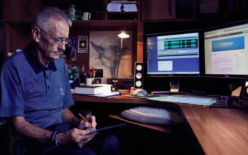I just finished reading American Ground, Unbuilding the World Trade Center, by William Langewiesche, paperback version with afterword. The author copyrighted his research in 2002 and the paperback version was published in 2003.
I did not work on the World Trade Center story while on the Commission and, therefore, have not written much about it. However, Langewiesche touches on an issue important to me, Chaos Theory, and I need to address it.
Chaos Theory
Langewiesche, as do nearly all writers, researchers and historians, uses the word “chaos” ubiquitously and without definition. The word is used as an accepted descriptor, understood by all.
In earlier articles I have established my use of Chaos Theory to understand and put in context the events of 9-11. In particular, I have established that we can use Chaos Theory as a metaphor and that we can use its language to describe things.
One such description is the fact that in Chaos things self organize in ways that cannot be predicted and strange attractors emerge because information flows to entities or people around which things can reorganize.
Langewiesche describes such a set of circumstances concerning the “unbuilding” of the World Trade Center, one in which an unlikely entity and actors emerged and around whom things organized to deal with what the author, time and again, refers to as chaos.
[page 9] “The agency charged with managing the physical work was an unlikely one. It was the Department of Design and Construction (DDC), an obscure bureaucracy…whose offices were not even in Manhattan but in Queens. The DDC was given the lead for the simple reason that its two top officials, a man named Kenneth Holden and his Lieutenant, Michael Burton, had emerged from the chaos of September 11 as the most effective of the responders.”
And later, [page 11] “Their success in the midst of chaos was an odd twist in the story of these monolithic buildings that in the final stretch of the twentieth century had stood so visibly for the totalitarian ideals of planning and control.” But the buildings were not buildings anymore, and the place where they fell had become a blank slate for the United States. Among the ruins now, an unscripted experiment in American life had gotten under way.”
And finally, a description of the task [page 12]: “The weight alone defied imagination. What does a chaos of 1.5 million tons really mean?” Thereafter, the author will refer to the debris pile, itself, as “chaos.”
But how good is Langewiesche as a contemporary historian? The author provides us the answer. He took the time to describe the flights of AA 11 and UA 175 in a way that allows us to gage his research.
Primary source information, accurately reported
Beginning on page 75 and in seven succinct pages, Langewiesche, accurately told the primary source story of AA 11 and UA 175 using transcripts of the audio files from air traffic control and from American Airlines. His account is flawless, based on my own understanding and my own work with the air traffic control tapes. Using that benchmark to establish Langewiesche’s due diligence as an historian and writer, we can reasonably accept the rest of his work, specifically the following:
1. Beginning on page 54 Langewiesche described the deaths of, first, the South Tower, and then the North Tower as a specific result of the impacts of UA 175 and AA 11. “One of the many astonishments of that day was that the building [South Tower] was able to swallow an entire 767 and slow it from 590 MPH to a stop in merely 209 feet.” “…the building would have remained standing indefinitely. But then, of course, there was the fire…”
2. “On the debris pile in the northeast corner the fire melted the remnants of the shattered airliner, which half an hour after entering the building began to flow in a stream of molten aluminum down the tower outside.”
3. With its support giving way beneath it the top of the [South] tower tilted east and then south., rotating in a clockwise direction, and suddenly slammed down.” “…it was not felled from below, it was hammered from above and it accelerated as it fell crushing the core and peeling back the exoskeleton with each successive floor.”
4. [North Tower] “…the 351-foot transmission tower on the roof sank a little…Half a second later the floors above the impact zone dropped as a unit straight down through the office fire, creating a flare-up and the illusion of a secondary explosion before striking the first blow in the chain of blows that pancaked the monolith to the ground.”
5. The words of one of the last persons found alive, one who survived the fall of the North Tower, Pasquale Buzzelli. “Buzzelli felt the building rumble, and immediately afterward heard a tremendous pounding coming at him from above, as one after another the upper floors collapsed in sequence. Buzzelli’s memory of it afterwards was distinct. The pounding was rhythmic, and it intensified fast, as if a monstrous boulder were bounding down the stairwell toward his head.”
Based on Langewiesche’s demonstrated due diligence in research and reporting I am confident that the conflagrations–the office fires–brought the towers down, that the molten metal “flowing out” was aluminum, and that the speculation by a few about controlled demolition is simply false.
Langewiesche’s work was criticized, but that criticism had nothing to do with his technical descriptions of the flights, their impact, the fires, or the collapse of the towers. It had to do with his treatment of the stakeholders, primarily the New York Fire Department, in the demolition effort. In the afterword to his paper back edition, Langewiesche showed his established due diligence by acknowledging and addressing the criticism of his original book.
